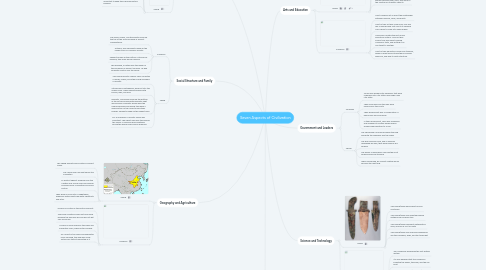
1. Arts and Education
1.1. Shang
1.1.1. The Shang/Zhou used a lot of bronze to make their artwork, because they had just dicovered it at the time.
1.1.2. The Shang/Zhou developed many schools over their rule all across China.
1.1.3. The Shang/Zhou used turtle shells to engrave their language on.
1.1.4. Bronze replaced jade, ivory, and stone in the crafting of ritualistic objects.
1.2. Sumerian
1.2.1. Most Sumerian art is about the relationship between humans, gods, and plants.
1.2.2. Most of their art was made from clay and has a rounded and soft look to it because clay is hard to make into sharp edges.
1.2.3. Sumerians created the first formal education system. Much of their school time was spent copying cuneiform texts, and putting it on one tablet to another.
1.2.4. Most of their education came from temples, where a priest would teach them complex grammar, and how to write literature.
2. Government and Leaders
2.1. Sumerian
2.1.1. Sumer was divided into kingdoms that were organized into city-states and kings ruled city-state.
2.1.2. They made laws and the laws were enforced by the courts.
2.1.3. Their government was a combination of democracy and monarchy.
2.1.4. In their government, labor was organized and assigned to certain people which allowed specialization to occur.
2.2. Shang
2.2.1. The Shang had a monarchy where the king was both the lawmaker and the judge.
2.2.2. The king ruled by force, and if anybody disobeyed his laws, they were killed by his soldiers.
2.2.3. The leader of whichever clan had the most soldiers would be the king.
2.2.4. When a king died, his closest relative would become the next king.
3. Religion
3.1. Sumerian
3.1.1. Sumerian myths were passed down through stories until the invention of writing.
3.1.2. Sumerians believed the universe was just heaven, and Earth.
3.1.3. Sumerians were polytheistic meaning they had many deities.
3.1.4. The Sumerians had great ceremonies to honor their gods.
3.2. Shang
3.2.1. Shang people were polytheistic meaning they worshipped many gods.
3.2.2. The main god people worshipped during the Shang dynasty was Shangdi.
3.2.3. The Shang people held huge festivals to honor their gods in order to get abundant harvests, or a reward.
3.2.4. A big part of the Shang religion was ancestral worship. They viewed it as very important to keep their dead ancestors pleased.
4. Social Structure and Family
4.1. Sumerian
4.1.1. The Kings, nobles, and the priests made up the top of the social Pyramid in ancient Mesopotamia.
4.1.2. Artisans, and merchants made up the middle class of Sumerian society.
4.1.3. Peasants made up the bottom of the social pyramid, they were poorer farmers.
4.1.4. The husband, or father was the leader of the household in ancient Sumeria. He had complete control over the family.
4.2. Shang
4.2.1. The Shang dynasty's upper class consisted of Kings, nobles, and other ruling members of society.
4.2.2. Artisans and craftspeople, were put into the middle class. These people worked with bronze, jade, and silks.
4.2.3. Peasants, and slaves made up the bottom of the social pyramid with peasants right above slaves. Peasants would work the Nobles farmland and would take back a small portion of the crops to feed their families. Peasants made up the largest class.
4.2.4. For all members of society family was important. The oldest male was the head of the family. If someone did something wrong the whole family was in disgrace.
5. Economy and Trade
5.1. Shang
5.1.1. Economy was built on the backs of the workers and farmers.
5.1.2. They used cowrie shells as currency because the shells were small, smooth, and beautiful and they were brought all the way from the Indian Ocean.
5.1.3. The Shang used trade routes to transport goods and to trade with other civilizations.
5.1.4. Fishing was an important industry to the Shang.
5.2. Sumerian
5.2.1. The invention of the wheel helped the Sumerians transport goods and made trading much easier.
5.2.2. The economic prosperity of the Sumerians made them a target for others to attack.
5.2.3. The economy of the Sumerians relied heavily on agriculture.
5.2.4. They also had small workshops like bakeries and brick-making workshops.
6. Science and Technology
6.1. Shang
6.1.1. The Shang/Zhou were expert bronze craftsman.
6.1.2. The Shang/Zhou also invented healing methods like acupuncture.
6.1.3. The Shang/Zhou had great mathematics skills, and focus a lot of math.
6.1.4. The Shang/Zhou also improved weaponary like the crossbow, ships, and the trebuchet.
6.2. Sumerian
6.2.1. The Sumerians developed the first writing system.
6.2.2. It is also believed that the Sumerians invented the wheel, the plow, and the sail boat.
6.2.3. Sumerians also invented levees to hold back water from the crops. This is the first form of irrigation.
6.2.4. The Sumerians also excelled at metal work and craftmanship.
7. Geography and Agriculture
7.1. Shang
7.1.1. The Shang Dynasty was located in ancient China.
7.1.2. The Yellow river ran right above the civilization.
7.1.3. To protect against flooding from the Yangtze and Yellow rivers by building complex forms of irrigation and flood control.
7.1.4. They grew rice and lots of vegetables, especially water plants like water chestnuts and lotus.
7.2. Sumerian
7.2.1. Sumeria is located in the Fertile Crescent.
7.2.2. The living conditions were not very good because the area was dry and did not get very much rain.
7.2.3. Sumeria is surrounded by the Tigris and Euphrates rivers, which often flooded.
7.2.4. As a result of the Tigris and Euphrates rivers flooding, the land was made fertile from the silt deposited in it.

